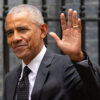When Mike Myers’ Linda Richman character would get a “little faklempt” on the Saturday Night Live skit Coffee Talk, she would give the audience a topic to discuss while she composed herself, like: “The Holy Roman Empire was neither holy, nor Roman, nor an empire. Discuss.” If Linda were still hosting her show today, she could as accurately say about today’s health care debate: “The public option is neither public, nor an option.” Let’s discuss.
For the leftist base of the Congressional majority, the creation of a government-run health insurance company has been the defining issue of the health care debate. So, Speaker Nancy Pelosi (D-CA) has explained numerous times that: “The thinking on the public option has been that it gives consumers more choices and it helps keep the private sector honest because there’s some competition out there.” But is this true? Would the public have more choices if a government run health insurance company was created?
Five different organizations and offices have made predictions of how many Americans could end up enrolled in the public option, including: The Lewin Group, the Congressional Budget Office, the Centers for Medicare and Medicaid Services, the Urban Institute, and Health Systems Innovations Network. They all tell a similar story: the number of Americans that end up in the government run plan will greatly depend on who is allowed to buy into it, and how much they have to pay.
The Lewin Group–an independent health care analysis firm–was the first to estimate the impact of creating such a new public plan, when University of California at Berkeley professor of political science Jacob Hacker worked with them to create a model health plan for the Economic Policy Institute. The left loved the numbers Lewin produced for Hacker’s plan, but they immediately turned on Lewin and began attacking its credibility once Lewin analyzed the actual legislation in the House.
What so angered the left was Lewin’s finding that if the government-run plan were open to all employers, 103.4 million Americans would find themselves with government run insurance, including 88.1 million Americans who would lose their current employer-sponsored private coverage. What angered the left so much about this finding was that it exposed the fact that there is very little “optional” about the public option. Those 88.1 million Americans would not be the ones choosing the public plan. Instead, it would be their employers who decided to discontinue their current private coverage, leaving the 88.1 million Americans no choice but to enroll in the government plan.
The latest version of Obamacare in the House “fixes” this problem by severely limiting who the government can enroll in the government plan. Under the new bill, only employers with 25 employees or fewer are allowed to enroll in the plan in year one (2013), in year two (2014) individuals and employers with 50 employees or fewer become eligible, and in year three (2015) employers with at least 100 employees become eligible. In other words, the vast majority of Americans will not be eligible to enroll in the allegedly “public” plan. Worse still, even the poorest Americans are specifically denied access to the new government plan. The bill does expand Medicaid eligibility to 150% FPL but it also appears to deny access to those who are “eligible” for Medicaid. This simply gives the false impression that poor people will get a choice of better care under this bill. The reality is all they get is a chance to join the substandard government-run Medicaid plan.
With these restrictions, the Congressional Budget Office has estimated that under the current bill (H.R. 3962) only 6 million people would enroll in the government plan. The Lewin Group has not analyzed H.R. 3962, but did estimate earlier that if a public plan was only open to employers with no more than 20 employees, 21 million people would enroll. The difference between the two numbers comes largely from the fact that the CBO estimates that the public plan would have higher, not lower, premiums than private plans.
Since the left in Congress has chosen to make the public option the defining issue of the health care debate, millions of Americans are set to be sorely disappointed if Obamacare passes and they suddenly learn that they are not eligible for the so-called public option they have been sold. The scariest part of Obamacare, however, is that the legislation also empowers the new Health Czar to unilaterally rewrite the regulations so that the public option can turn into President Barack Obama’s dream of “Everybody in, Nobody out” government run health care.
Quick Hits:
- The Obama administration’s thoroughly “scrubbed” stimulus jobs report includes a $26,174 project that purportedly created 450 jobs.
- The Obama administration said yesterday that Commerce Secretary Gary Locke was “imprecise” when he said President Barack Obama’s advisers are considering a second stimulus.
- Despite their anti-lobbyist rhetoric, the Obama administration has been infiltrated by dozens of Obama for America National Finance Committee members who raised hundreds of thousands of dollars for the campaign, according to the watchdog group the Center for Responsive Politics.
- It will only cost you $30,400 to dine with five U.S. Senators, Wednesday, at the Democratic Senatorial Campaign Committee’s Women’s Senate Network party, thrown by power lobbyist Heather Podesta.
- Hospitals in New York City and other urban areas are the primary targets of Medicare cuts that help pay for Obamacare.
























